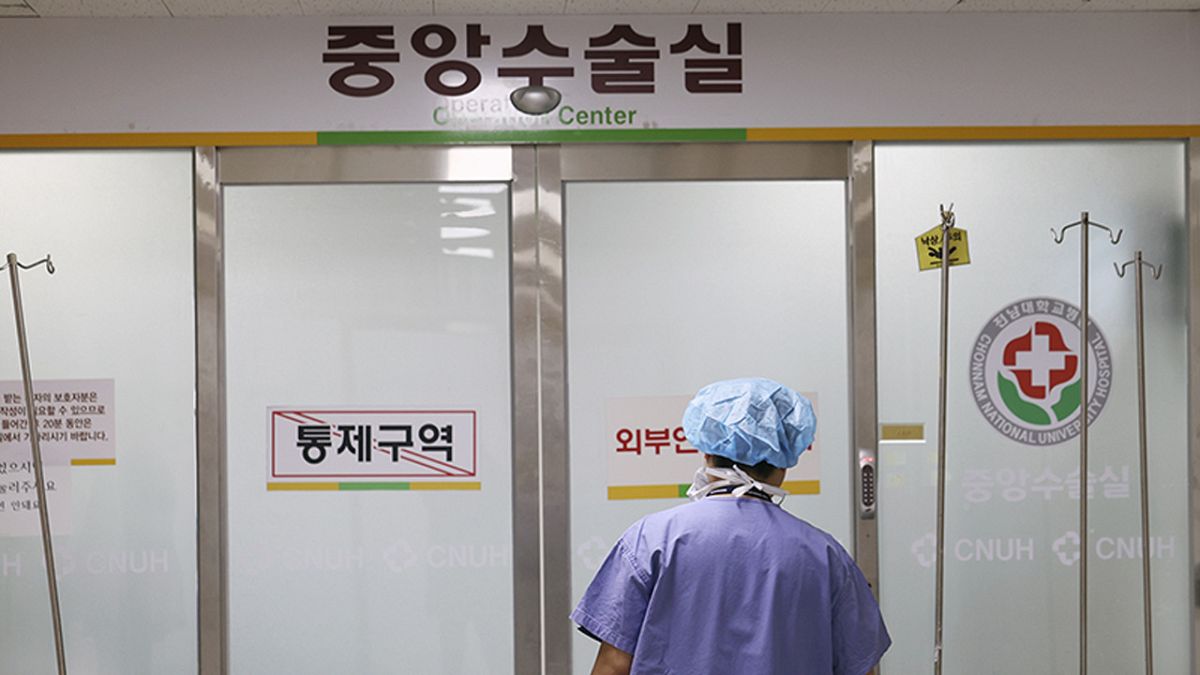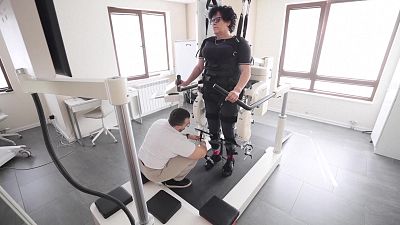The Korean government gave junior doctors a legally binding deadline by the end of February, but only a fraction of them have returned to their jobs.
Nearly 10,000 South Korean junior doctors have resigned in an act of protest against the government's new plan to recruit more medical students, leading to treatment cancellations and delays in hospitals.
In February, the South Korean government announced that 2,000 more medical students would be admitted starting next year, up from the current 3,058.
The reason given for the decision is that South Korea is far below the Organisation for Economic Co-operation and Development’s (OECD) average of 3.7 physicians per 1,000 people in the developed world, hovering at 2.1.
South Korea has the most hospital beds per 1,000 patients among OECD countries with 12.8 beds per 1,000 patients. This is more than twice the number of beds in France and six times more than in Sweden.
But the country has been grappling with doctor shortages in some key professions, such as obstetrics and paediatrics, and rural regions outside the greater capital area as the population ages.
Europe has also seen health workers go on strike recently, demanding better work conditions amid workforce shortages.
In 2023, the UK’s health authority announced a long-term plan which includes doubling medical school training places to 15,000 by 2031 from the current 7,500, amid an ageing population, for instance.
Observers say what’s happening in South Korea is different because of the unique structure of the South Korean healthcare system.
How South Korea's healthcare system differs
According to the local doctors’ association, most doctors are not employed by the state but medical fees are strictly controlled by the government.
While South Korea provides universal healthcare through the national insurance service run by the health ministry, more than 90 per cent of hospitals are privately owned, according to the OECD, and the top five tertiary hospitals are run by conglomerates such as Samsung and Hyundai.
"In Western Europe such as Germany and the UK, doctors work for publicly-funded institutions as public servants. In Korea, doctors are employed at private hospitals or open their own clinics," Sooho Joo, the spokesperson for the Korea Medical Association Emergency Response Committee, told Euronews Health.
"We are basically business owners. So comparing sole proprietors with public servants is unreasonable".
The striking doctors-in-training claim that most of the additionally recruited medical students would also likely try to work in high-paying, popular professions like plastic surgery and dermatology, like current medical students.
That means the country’s long-running shortage of physicians in essential yet lower-paying areas like paediatrics, obstetrics, and emergency departments would remain unchanged.
Instead of increasing the number of medical students, doctors’ groups want officials to use available resources to raise medical fees they say are set too low by the state.
"The current problem in Korea is that many doctors go to departments where work-life balance is possible, where they can have a lot of free time, and where they can receive more compensation for the treatment they provide," Joo said.
"So we, the doctors, ask that the judicial risk (for medical accidents) be reduced so that more doctors can go to departments such as internal medicine, surgery, paediatrics, and obstetrics and gynaecology. And we ask for appropriate compensation for the doctors who go to these departments".
Critics of the strike told local Korean media that the medical school caps could impact junior doctors in particular as they would compete with the new recruits in the labour market.
'More public hospitals and healthcare workers are needed'
Some agree that more doctors are needed but argue that the government’s changes lack a concrete plan to encourage doctors to move to rural regions and essential services.
They believe the country’s decade-long laissez-faire approach to the medical industry is the fundamental problem and that stronger state intervention to bring doctors to areas suffering shortages can be a solution.
"Currently, there is no public system responsible for creating a health workforce [in specialist areas]," Yi Seoyeong, a project manager at the Association of Physicians for Humanism (APH), told Euronews Health.
"It’s completely up to individual doctors where and how the trained doctors work after training. In this profit-oriented medical environment in Korea, doctors' activities are ultimately concentrated on profit-oriented inessential areas and unreimbursed care that is not covered by health insurance," Yi added.
According to the OECD’s Health Statistics published in 2021, only 8.8 per cent of hospital beds in South Korea are public, compared to 100 per cent in the UK and 61.5 per cent in France.
The Association of Physicians for Humanism, an NGO that works for those left out of the health system due to poverty, state violence, discrimination, and inequality, suggests establishing more public hospitals "that will take responsibility for providing medical services in the wards and regions that are neglected by the market-oriented medical system".
APH also suggests establishing a university or faculty dedicated to training public health care professionals where graduated doctors can only work at public hospitals.
"We believe universities should admit more medical students…[But] with the current structure, the problem will only worsen," said Yi.
Yi believes the South Korean healthcare system that makes doctors react sensitively to market competition is the ultimate problem.
"I believe that the reason these junior doctors are demanding complete cancellation of the expansion of medical schools is a strategy to maintain a high-income job by keeping the value of their labour scarce since they will become self-employed or salaried workers after obtaining the speciality training," said Yi.
Conflict creating 'medical gap'
As of February 27, some 9,937 junior doctors have handed in their resignations, which account for 80.8 per cent of junior doctors of all 99 teaching hospitals according to the Ministry of Health and Welfare of South Korea.
Some 4,992 medical students from 40 universities in South Korea are boycotting classes, according to the education ministry.
Most of South Korea’s 13,000 trainee doctors work at its 100 teaching hospitals, assisting senior doctors during surgery and treating patients. In some major hospitals, junior doctors account for about 30 to 40 per cent of the total doctors.
The health ministry urged them to return to work immediately, saying they must not endanger the lives of patients to fight the government.
South Korea's medical law allows the government to issue back-to-work orders to doctors when it sees grave risks to public health.
Those who refuse to abide by such orders can have their medical licenses suspended for up to one year and also face up to three years in prison or a 30-million-won (roughly €20,760) fine.
Those who receive prison sentences would be stripped of their medical licenses.
The Korean government gave junior doctors a legally binding deadline by the end of February, but only a fraction of them have returned to their jobs.
Local media reported that the government has launched a full-fledged investigation by seizing and searching the offices and homes of the current and former representatives of the Korea Medical Association.
It also announced that it would initiate penalty procedures against those who didn’t return to their jobs before March.
“Currently, the conflict between the government and doctors is creating a huge medical gap... and it is becoming a problem of life and safety, but I don't think there will be much to be gained from this," said Yi.
"The most key stakeholders are citizens and patients, but their interests are not being reflected in this discussion".
According to the health ministry, 256 surgeries and 15 hospital admissions have been delayed since the doctors started leaving the hospitals.
It has raised the health crisis level to “severe” for the first time apart from epidemics such as COVID-19.
The South Korean government has implemented emergency measures to minimise damage to patients caused by the walkouts, for example, by deploying military doctors, extending the working hours at public medical institutions, and giving nurses legal protection to conduct some medical procedures typically done by doctors.
For more on this story, watch the video in the media player above.



